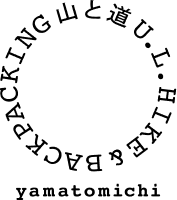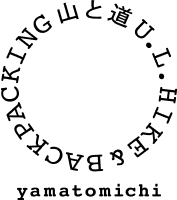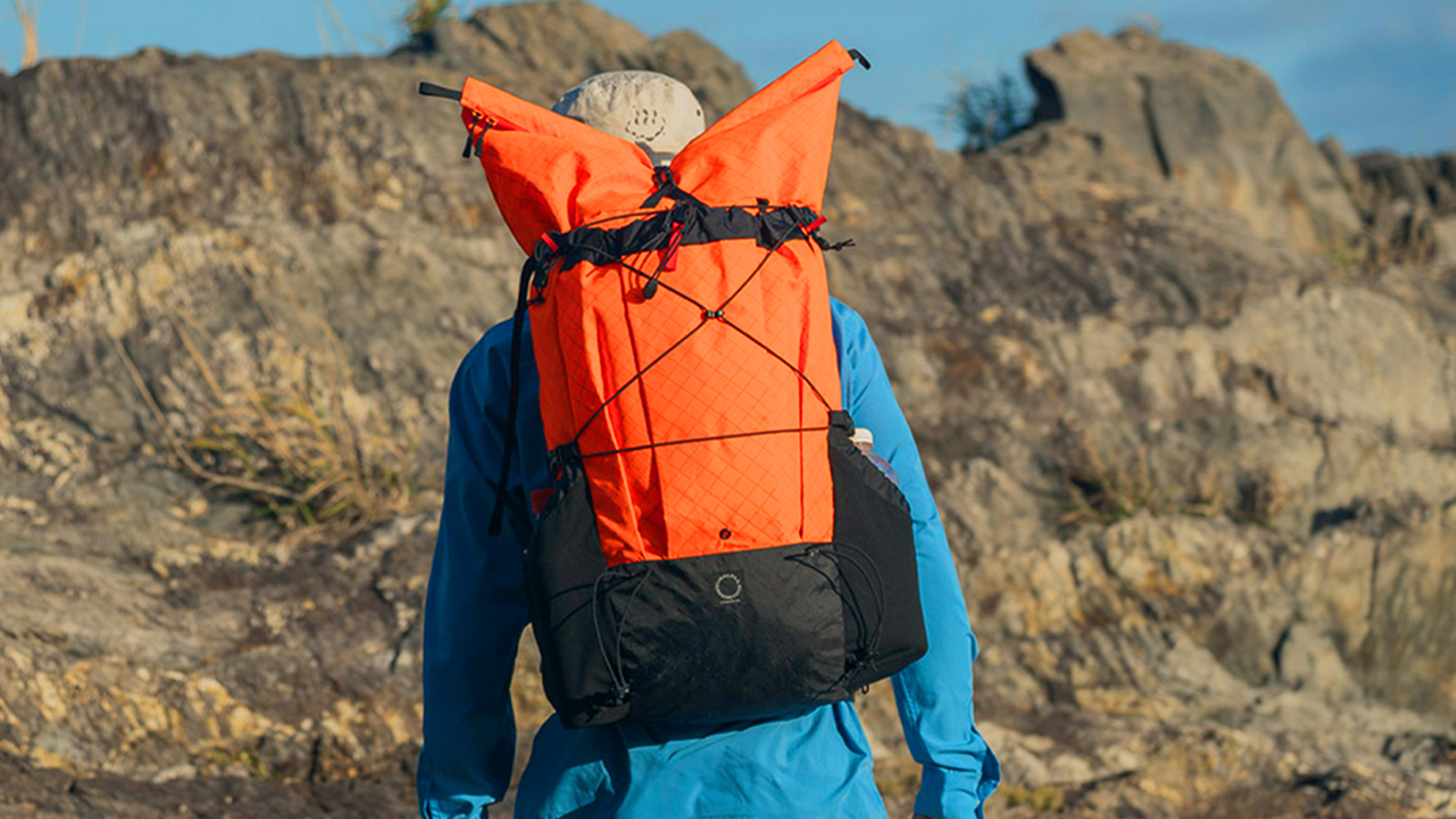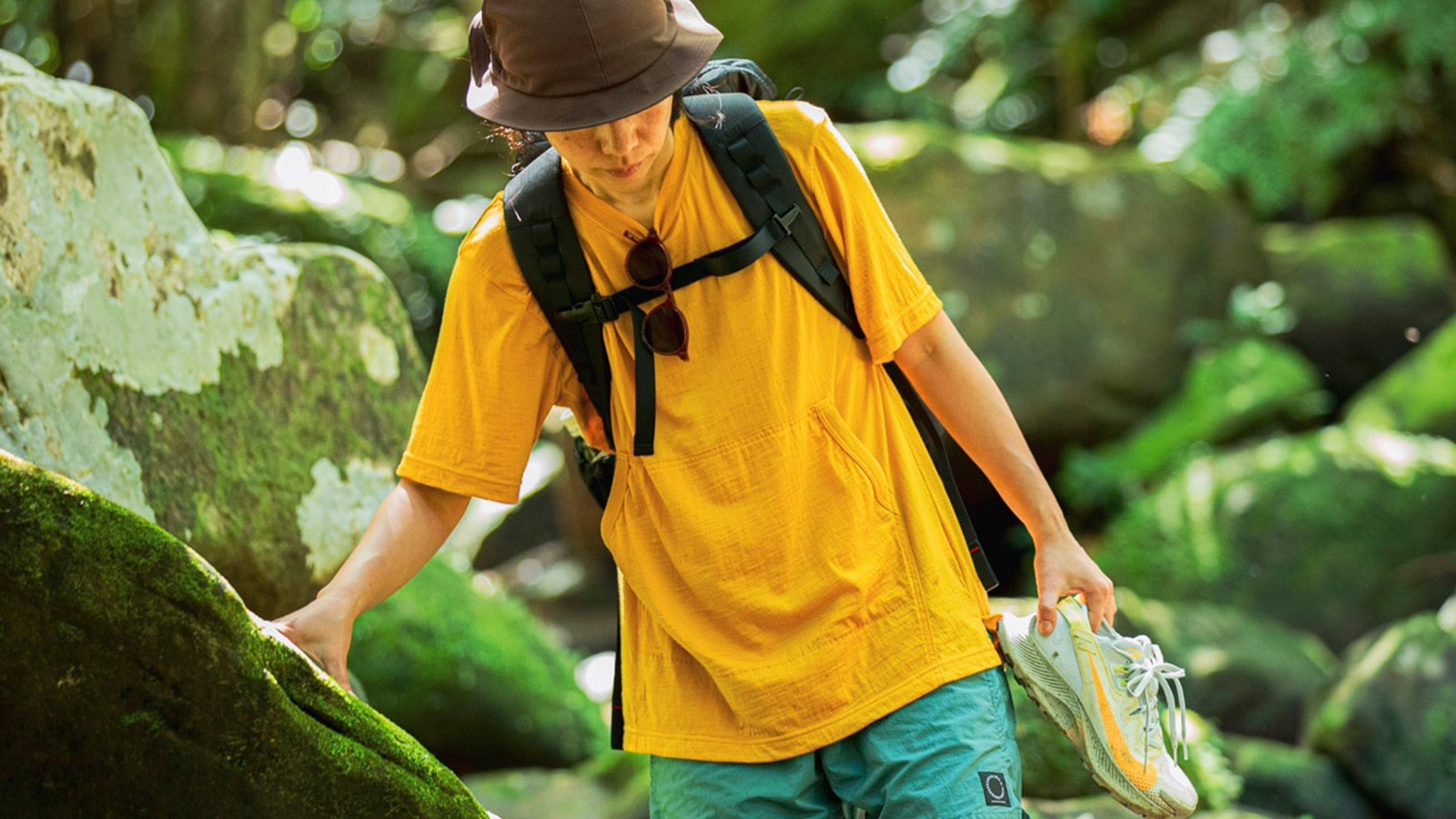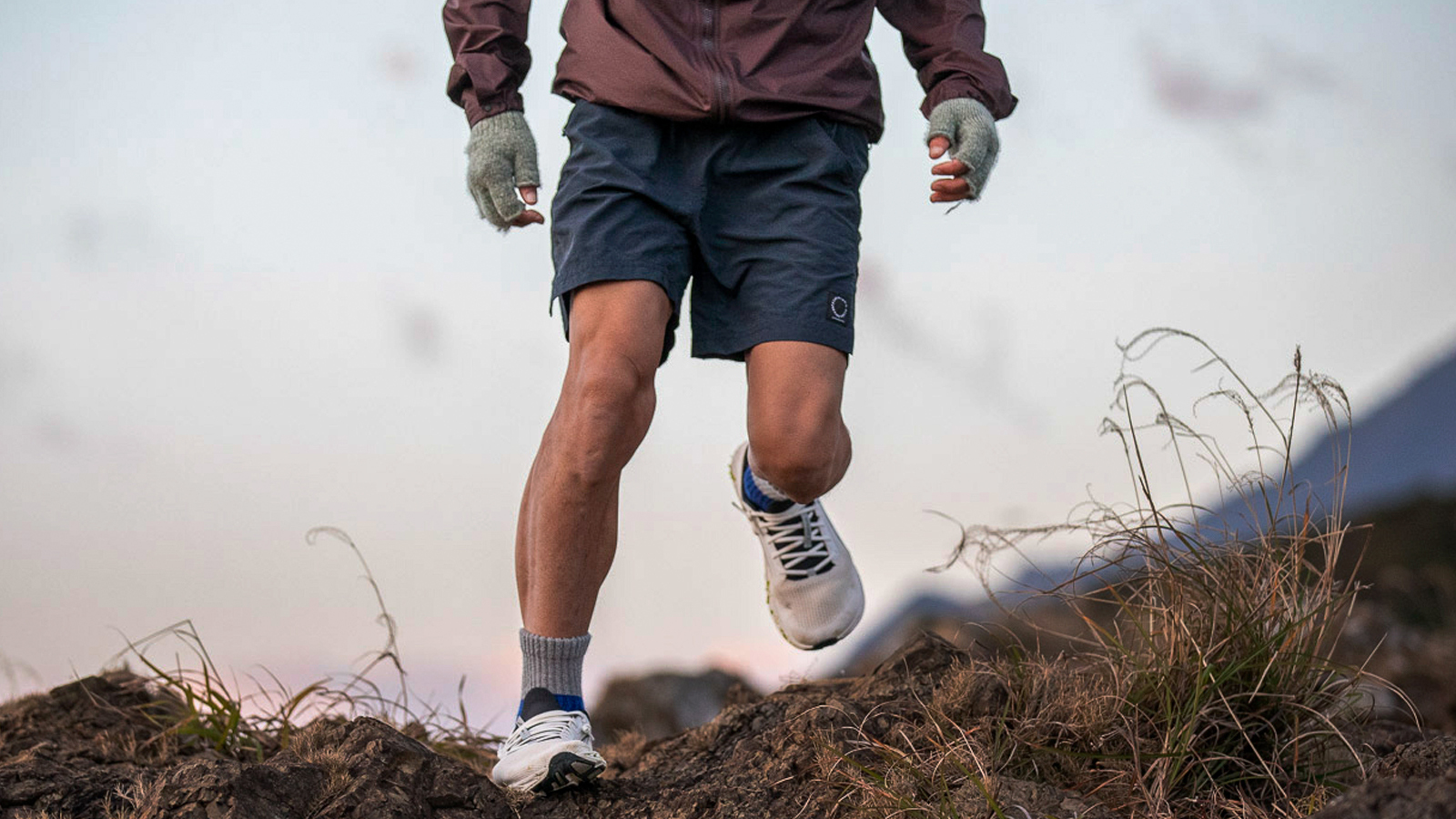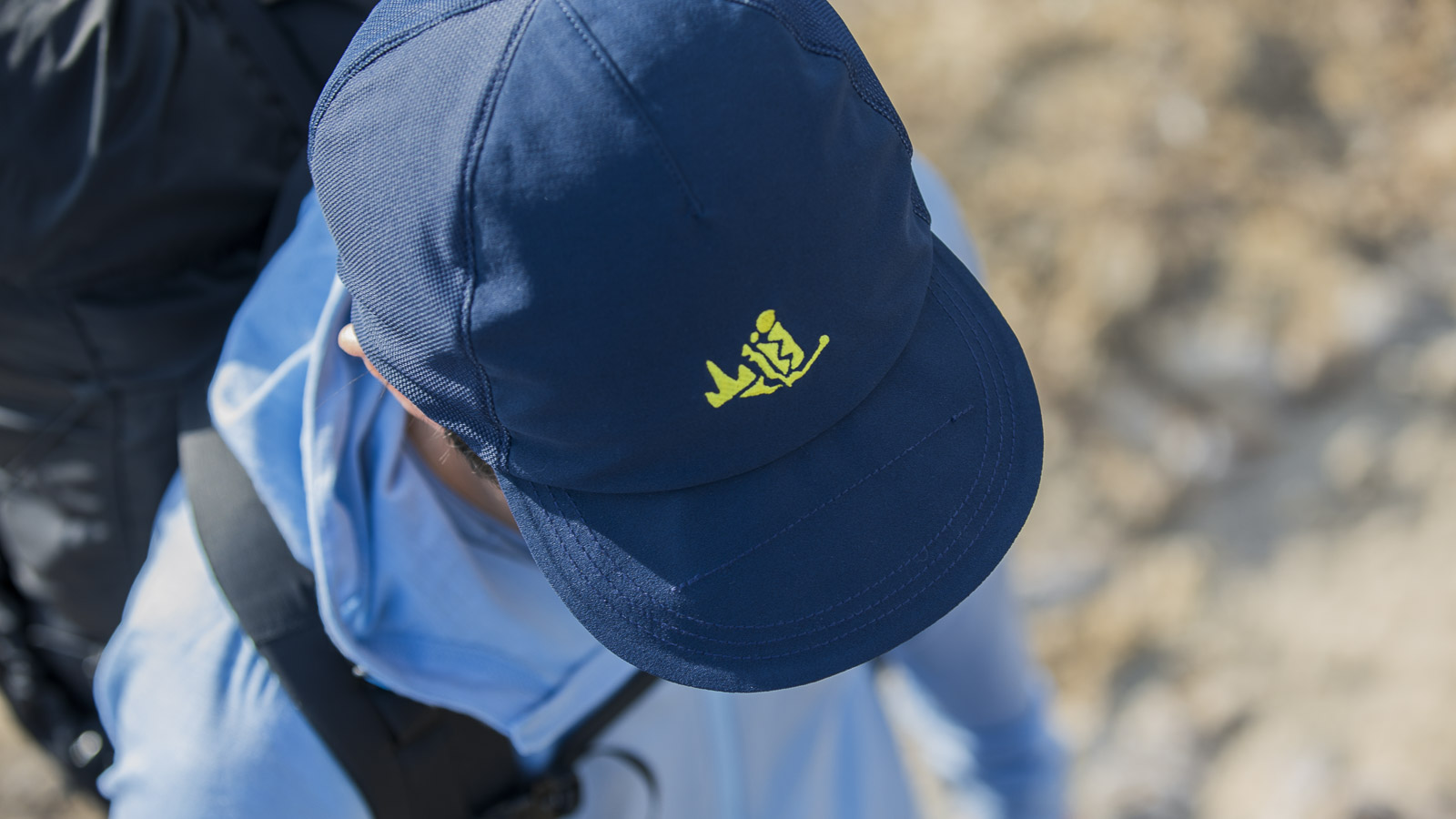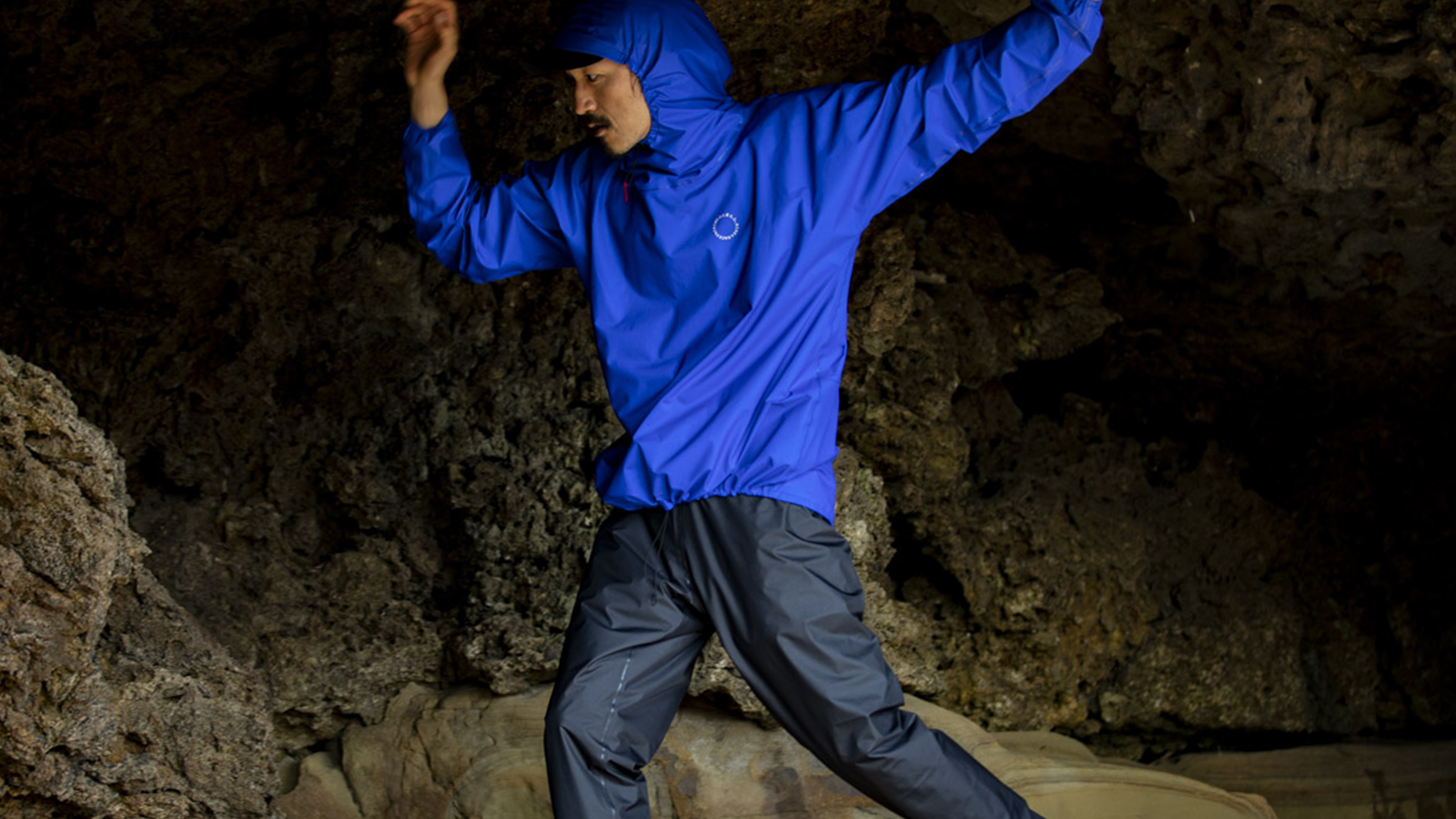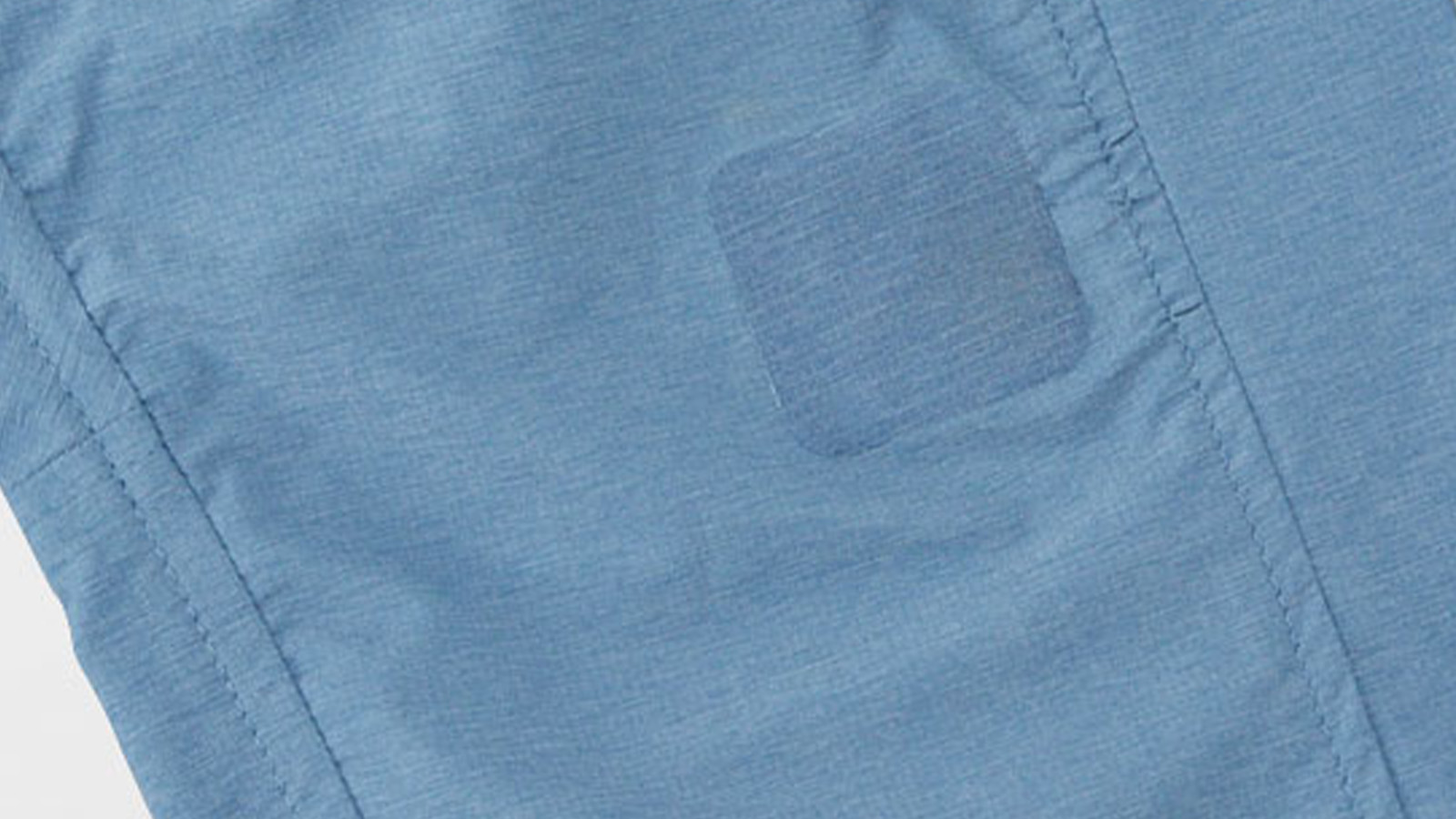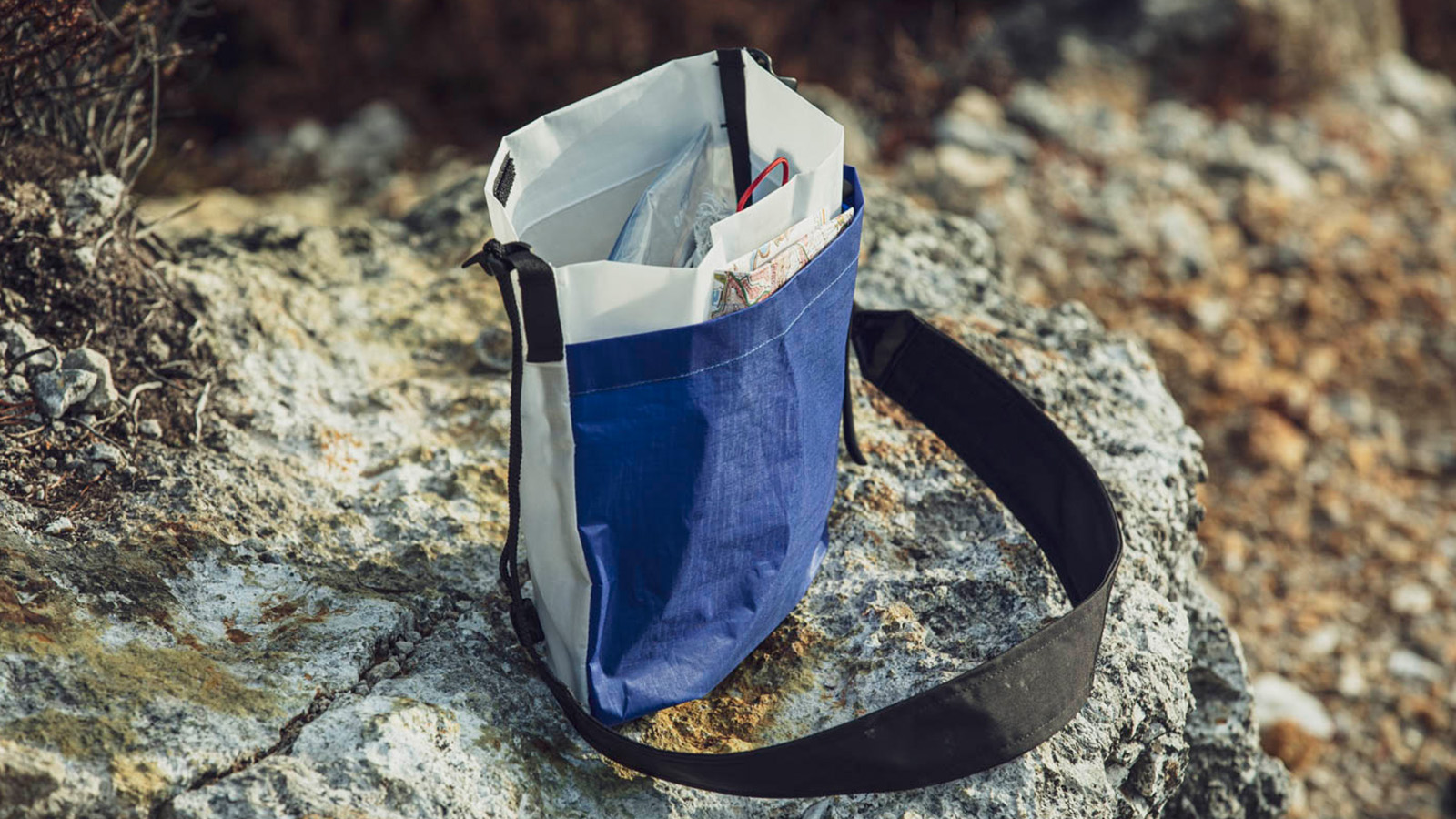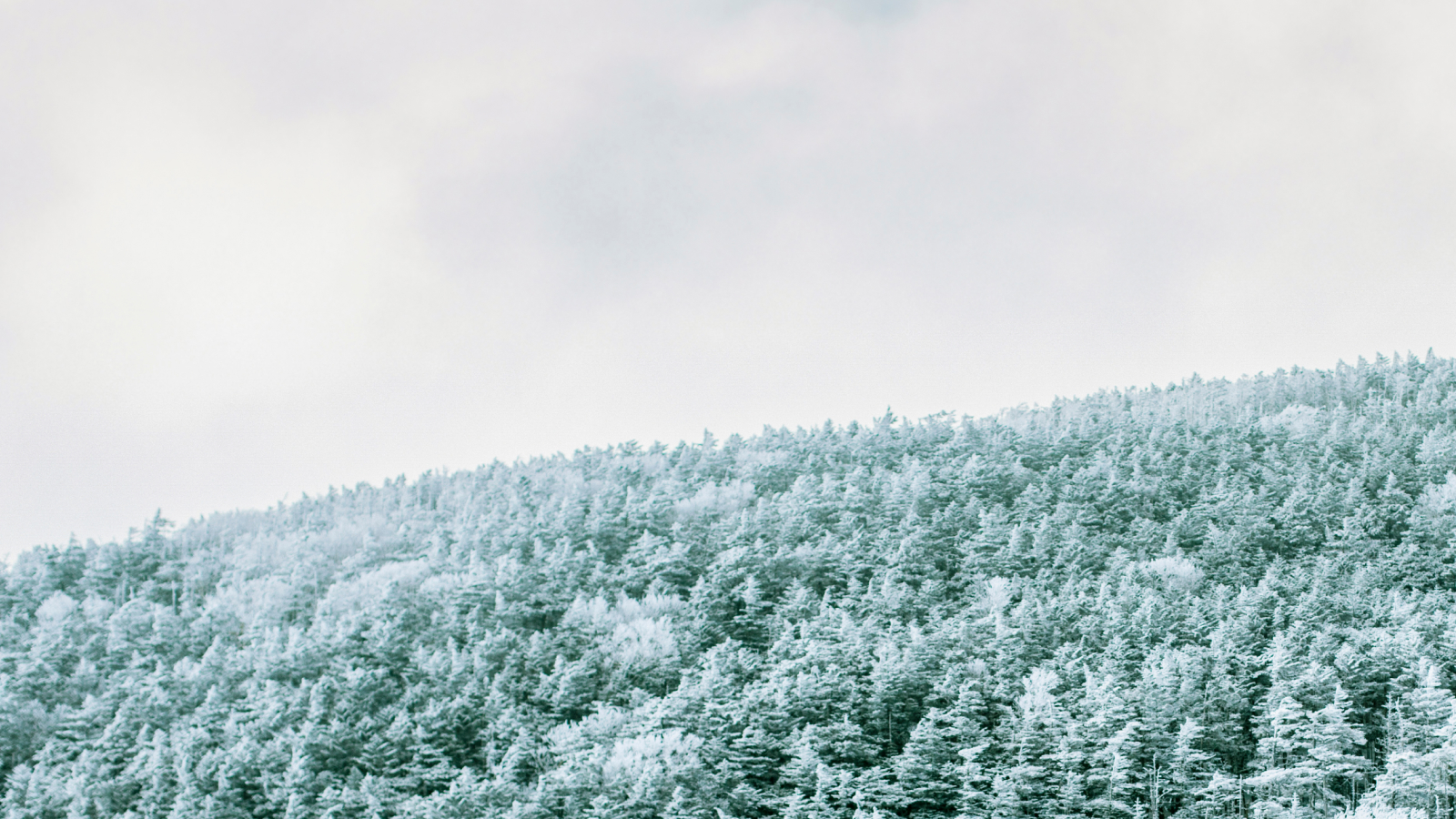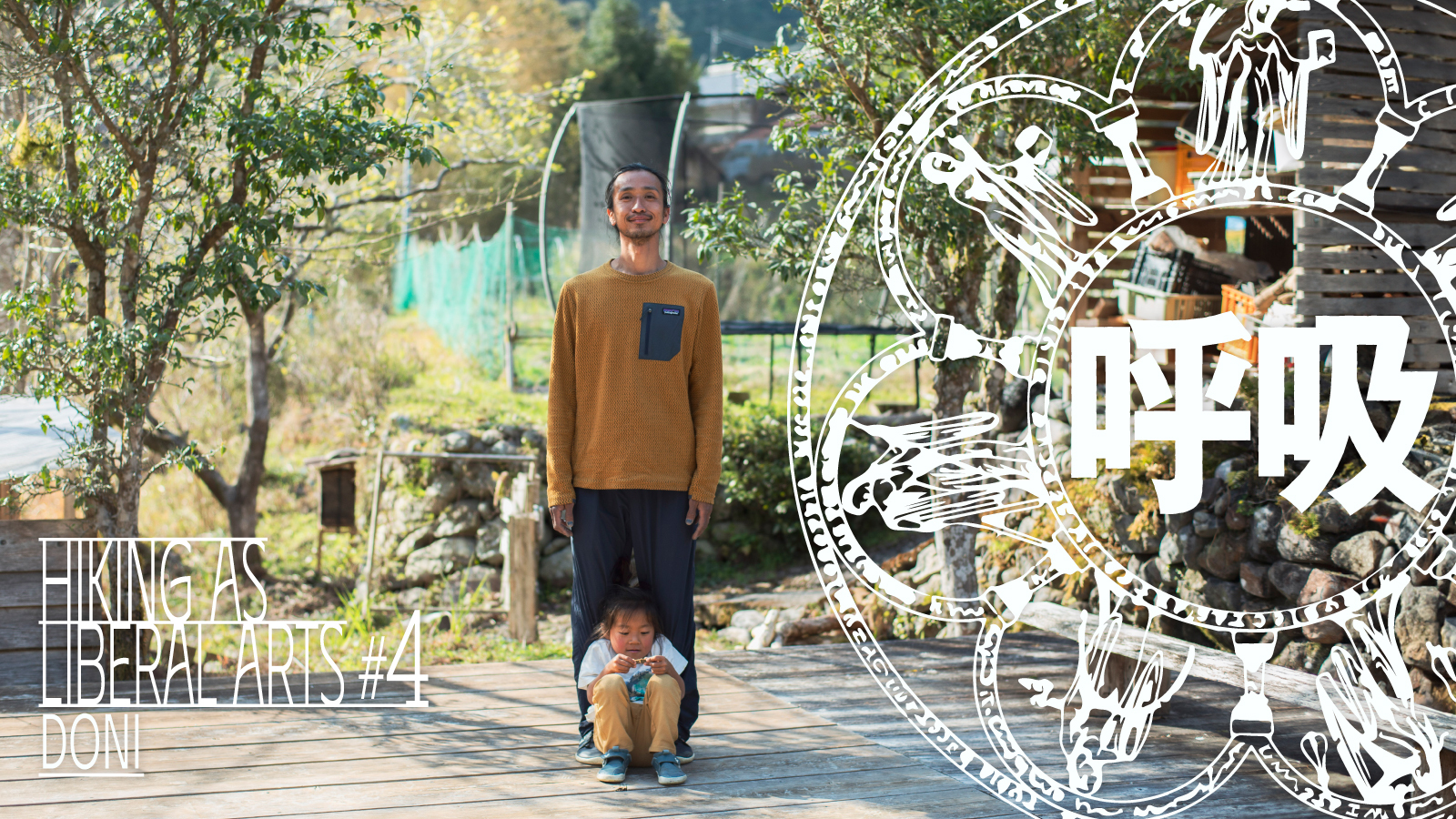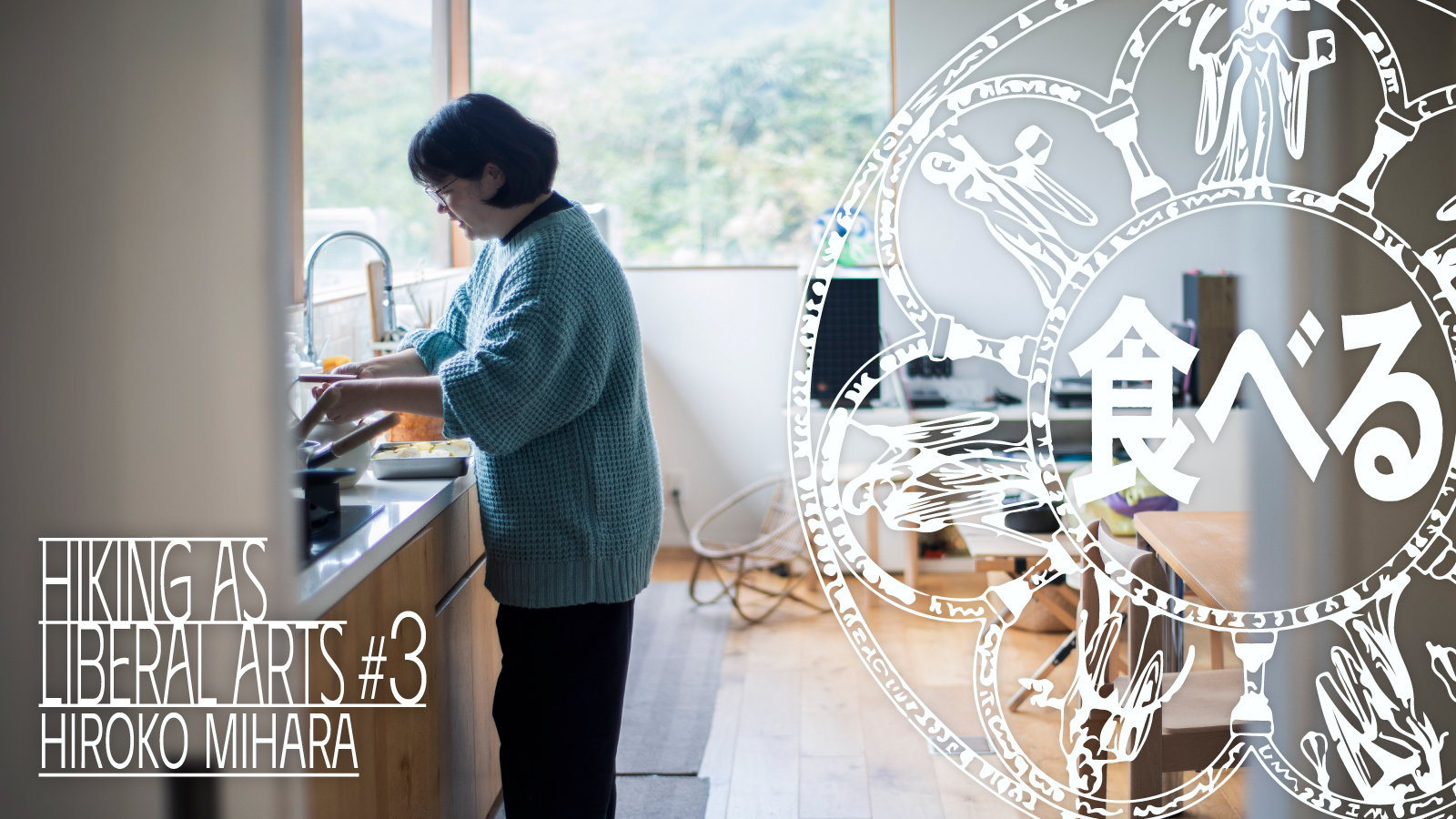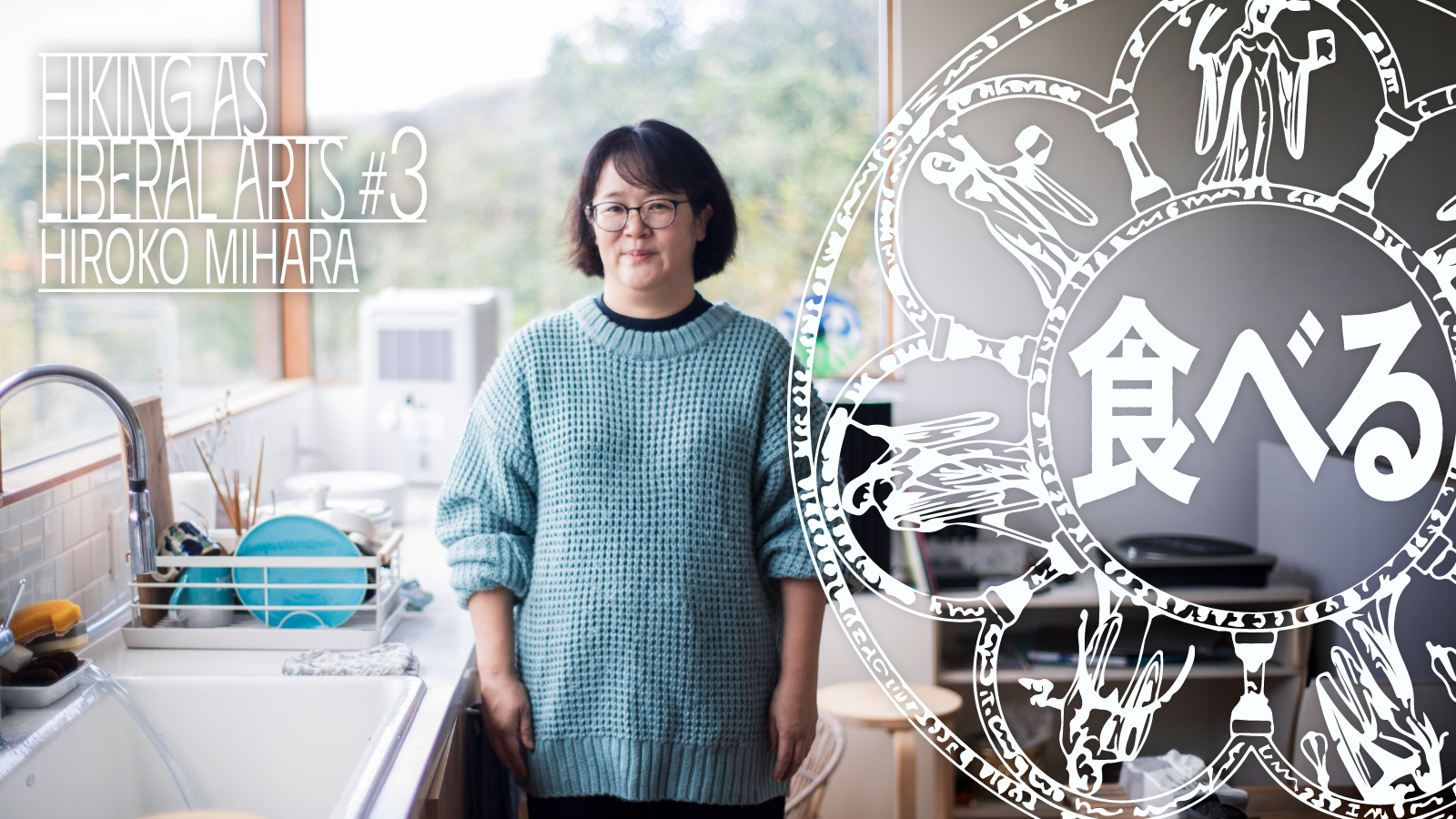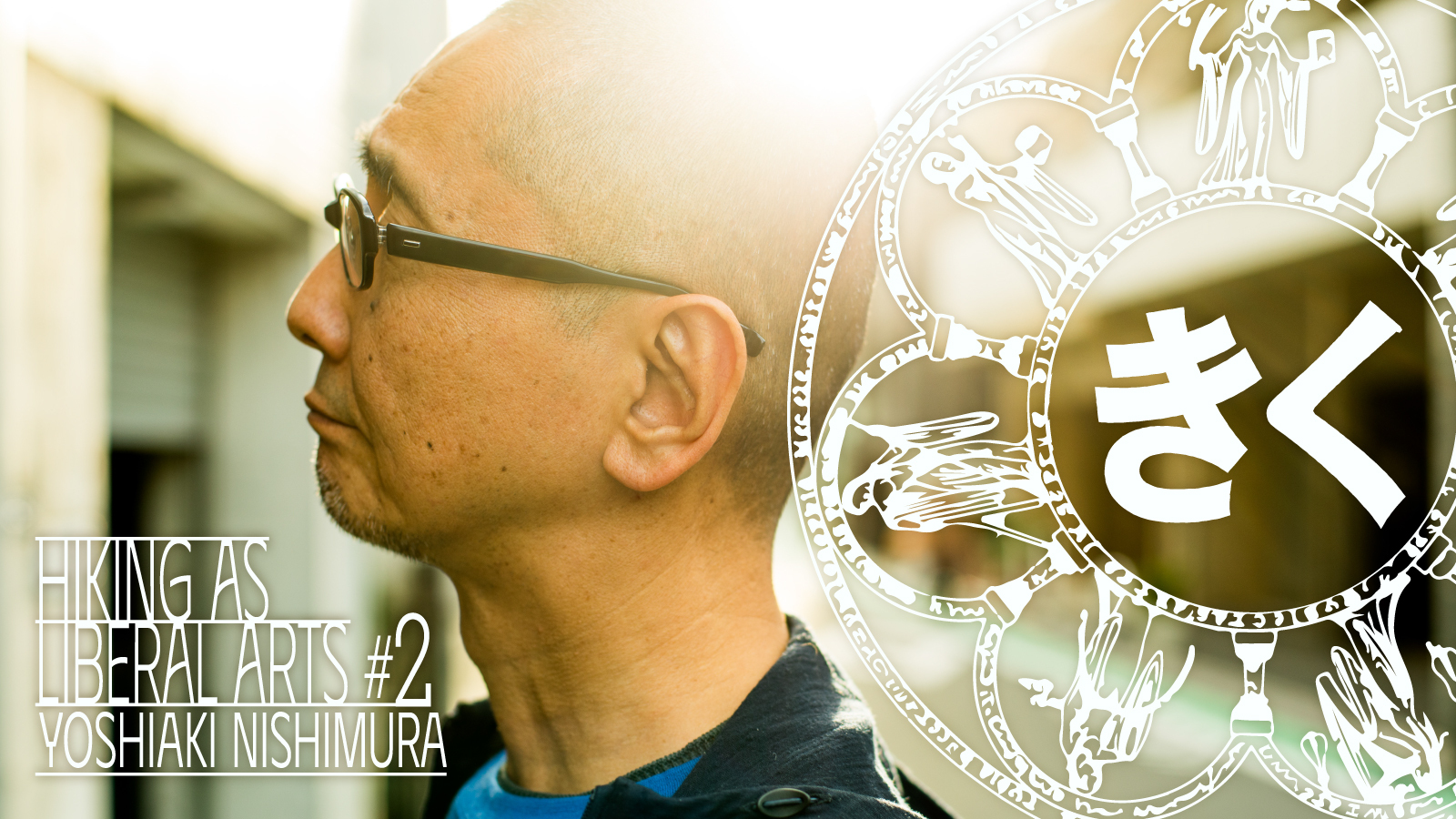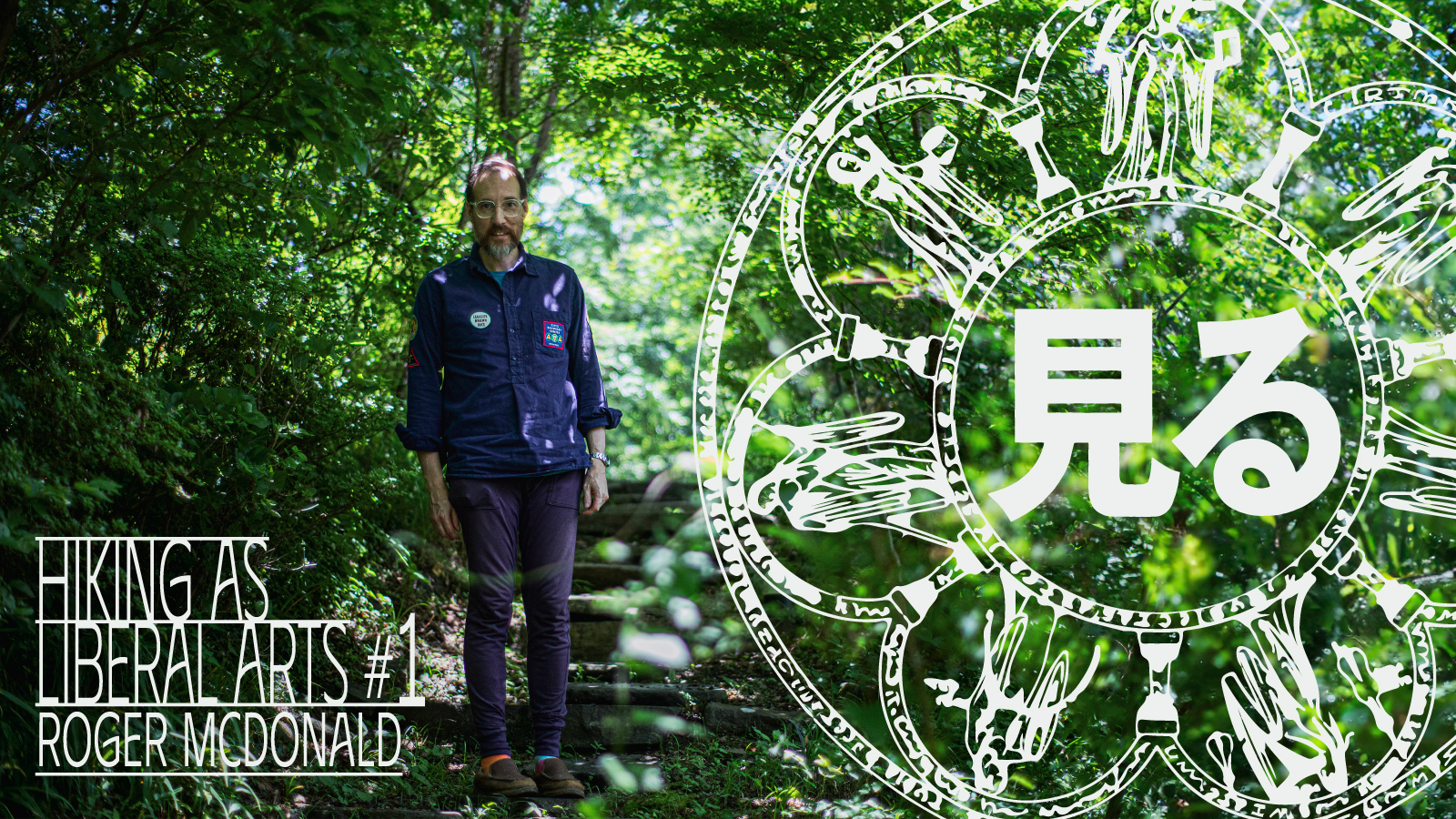DONI “Breathing” #1
Composition/Writing: Takuro Watanabe
Editing/Photography: Masaaki Mita
DONI “Breathing” #1
Composition/Writing: Takuro Watanabe
Editing/Photography: Masaaki Mita
In the HIKING AS LIBERAL ARTS series, hosted by Hideki Toyoshima, Yamatomichi HLC (Hike Life Community) director, we consider hiking as a liberal art, a field of study that liberates individuals from preconceived notions and norms, empowering them to act based on their own values. This series delves into physical aspects of hiking ー seeing, hearing, eating, breathing ー for clues to exploring the value of and potential that extends beyond hiking.
Our fourth guest of the series is DONI, a yoga practitioner who runs Kuo Green Village, a remote retreat in Kaiyo, a small town in Tokushima prefecture, and is working on opening a free school. Our conversation explores the power of breathing ー a vital aspect of living and a key element in the practice of yoga.
Interview Notes: Hideki Toyoshima
Our first guest in the series, Roger McDonald, broadened our understanding of “seeing”; our second, Yoshiaki Nishimura, deepened our capacity for “listening”; and our third, Hiroko Mihara, shared insights into eating. With our fourth guest, DONI, we turn our attention to breathing.
Ultralight hiking hinges on doing more with less. There are similarities to lifestyle movements like decluttering and minimalism but also to philosophies and practices such as Zen and yoga. In ultralight hiking, you draw on your experience and knowledge to make choices ー carrying only essential gear, for instance ー that allow you to immerse yourself in nature. The simplicity is both a guiding principle and universal truth, and it applies to many aspects of life, including breathing. With DONI as our guide, we explore breathing in its many forms.
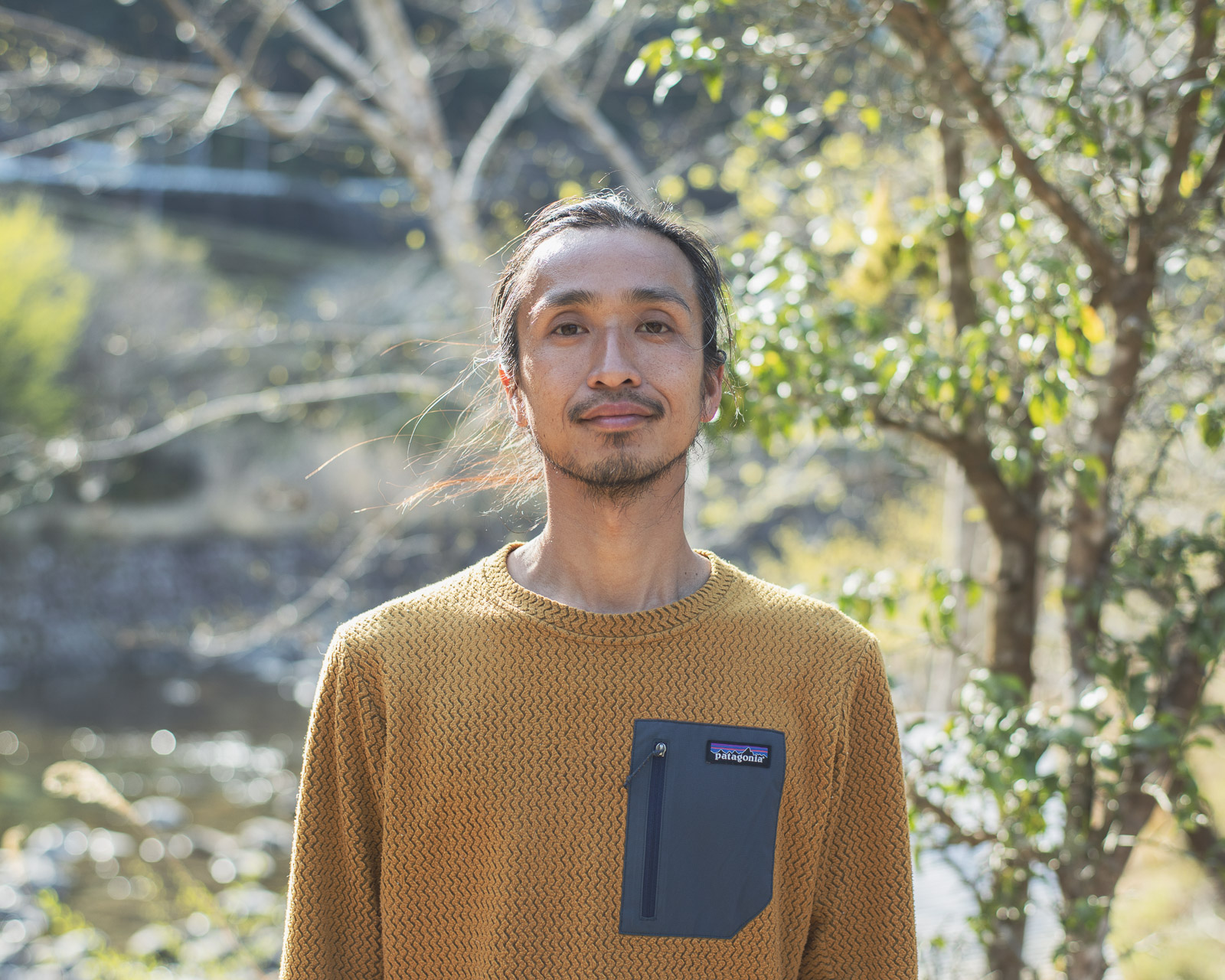
DONI DONI
Yoga practitioner and teacher, educator, environmental activist. A native of Kanagawa prefecture, DONI practices and teaches yoga while shuttling between India and Japan. He leads a near-self-sufficient lifestyle and works to give people the opportunity to live closer to nature ー and their true selves. He runs Kuo Green Village, a retreat in the mountains of Tokushima prefecture, where people can practice yoga and reflect on environmental issues. In 2026, he plans to open Shizen School Kitomori for children to find their own path.
Lifestyle choices
ーI want to ask about your interpretation of breathing. But before that, please introduce yourself, starting with the reason for your name. Why DONI?
DONI is the nickname that I’ve had since high school. It started as a joke between classmates at my all-boys school. Someone said, “You look like you’re from the Dominican Republic.” Initially, my nickname was Dominica, but that was a mouthful, so it got shortened to DONI. And it stuck. Even as my circle of friends grew, everyone ended up calling me DONI.
While I was in college, I started to get interested in yoga and meditation. Then a hike in the mountains transformed my life. Amid all of that, I came to the realization that DONI conveyed my true self, so I’m thankful for the name.
ーWhere are you originally from?
Yokohama, in Kanagawa prefecture.
ーHow long did you live in Yokohama?
Until I graduated from university. After that, I joined an advertising agency based in Osaka, but I was living in Kyoto. I’d dreamt about working in the media industry and had applied to several companies. But by the time I got hired by the Osaka company, I had already discovered hiking, and I wasn’t comfortable living in a big city. Instead, I chose to live along the Kamo River in Kyoto, where I was close to nature but within commuting distance of the office. I stayed in Kyoto until I left that job.
ーThe lifestyle you led while working at the Osaka ad agency feels like the opposite of your current lifestyle.
It really was. But I also feel that the essence of what drives me hasn’t changed all that much. Originally, I wanted to become a schoolteacher. But as my thinking evolved, I set my sights on the advertising world. Eventually, though, something was off. I began teaching yoga, and now I’m working to open a free school.
Advertising, yoga and free schools might seem completely different, but for me their common link is my motivation to share what I love. With advertising, for instance, I wanted to communicate what I truly believe in. I think that continues to guide me today.
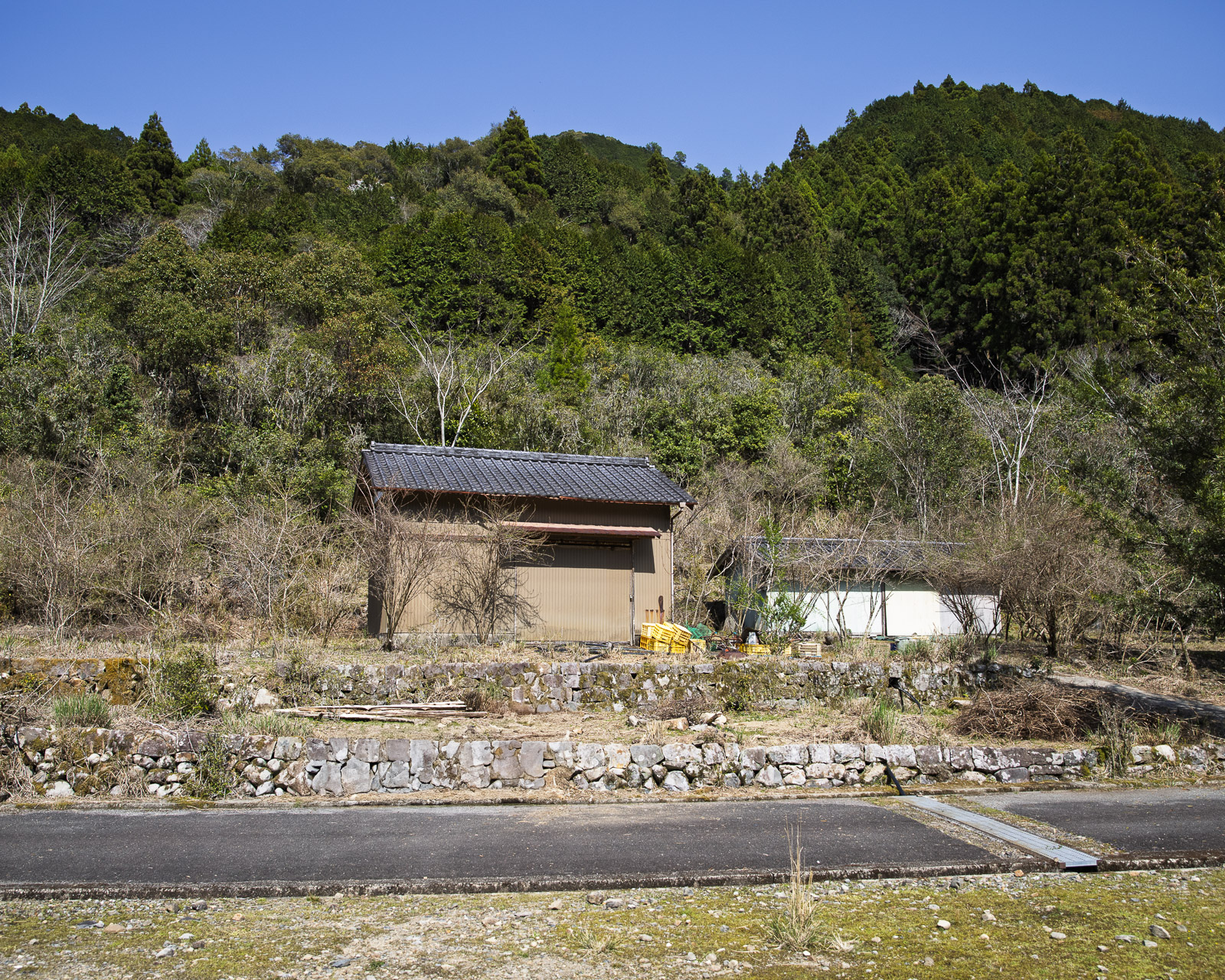

The future site of DONI’s school. Located in rural Tokushima, the plot opens onto a grassy field that a river runs through.
A life-changing encounter
ーYou mentioned that going into the mountains marked a turning point for you. How did that all begin?
When I was in university, I was living it up at night, going out to clubs, drinking ー the opposite of how I live now. I that never felt like that was my true self. I often wondered: “Who am I, really?” I was going along with what everyone else was doing and it felt empty.
Back then, I was working part-time for Tarzan magazine at publisher Magazine House. One of my coworkers invited me to climb Mt. Fuji. At the time, I had no hiking experience. I wore jeans, a hoodie and sneakers, and I bought a flashlight and carried just one bottle of water.
We left from the foot of the mountain at night, thinking we’d reach the summit in time to see the sunrise. But we were exhausted and ended up watching the sunrise from the 6th or 7th station (there are 10 stations on the mountain). I thought I was going to freeze to death. I was the textbook example of an inexperienced hiker ー someone who’d get harshly criticized today. We eventually made it to the top around noon, but it was brutal. I really felt like I was going to die.
That was my first experience hiking a mountain. A year later, I felt the urge to go back, even though I could only recall how bad it had been the first time. I told this to one of the three who had climbed Mt. Fuji with me and he said that he felt the same way. After that, the two of us started hiking in the mountains regularly.
This was about 20 years ago, before the whole yama-girl hiking boom (yama means mountain). It was still rare for young people to go into the mountains. In the Southern Alps, especially on weekdays, there were times when we wouldn’t see anybody else. Just climbing, exploring in solitude ー that was time when I felt truly myself.
ーSo through hiking, you found what you had been searching for.
Before that, I’d tried music, photography and other things while at university, but something was missing. When I was hiking in the mountains, I felt fulfilled.
The name I use for my Ashtanga Yoga classes, Mountain & Ocean, is something I came up with after about 10 years of hiking. Later, I also discovered surfing, and the ocean became another foundation for my yoga practice. So the name reflects the teachings I received from both the mountains and the sea. But hiking gave me the time and space to truly look inward.
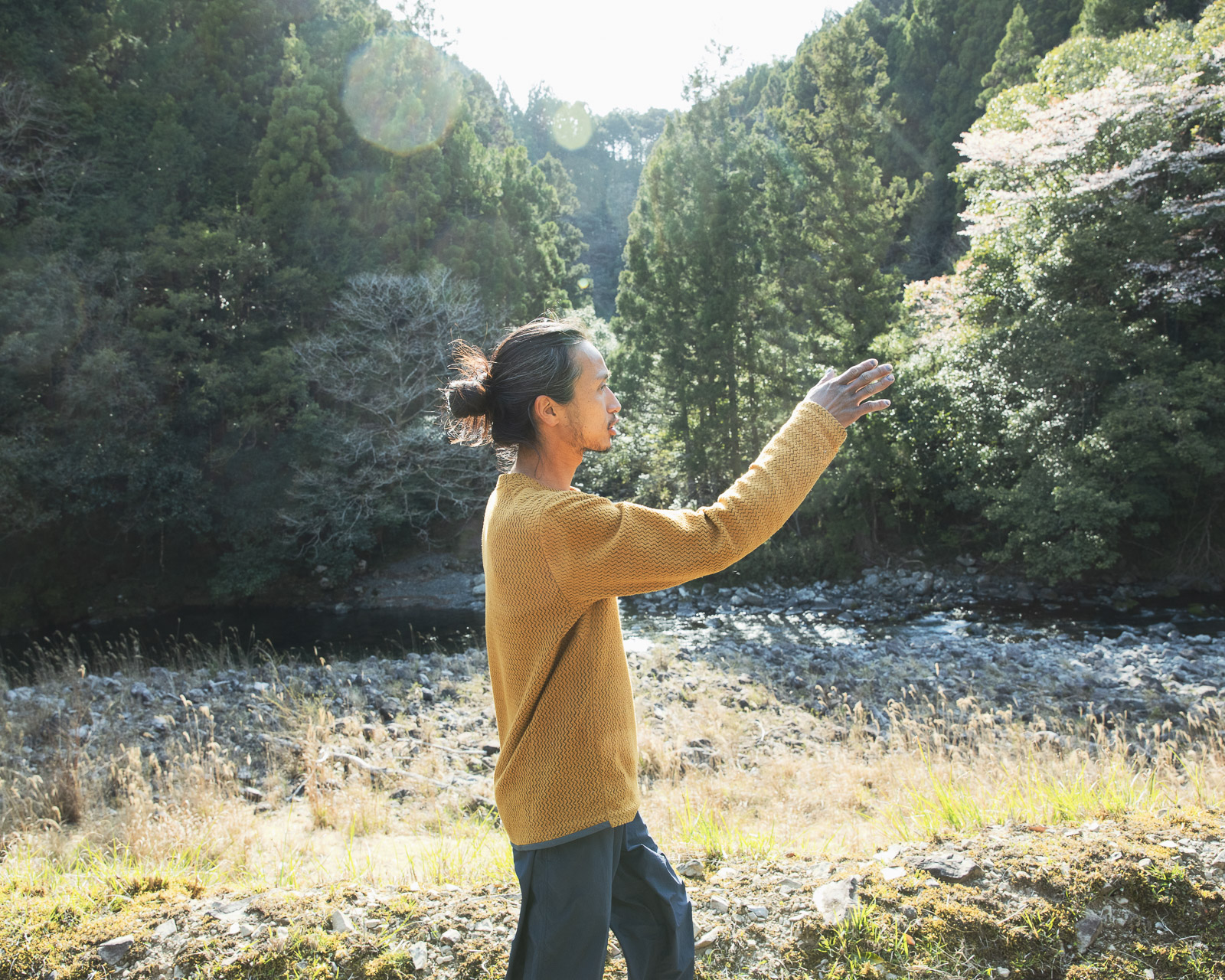
ーTell us about your current and past work, starting with an earlier project, DONI’s House.
Back then, I was living in Yamashina ward, in eastern Kyoto. I had left the advertising agency because I wanted to study yoga and then ended up going to India. I had no home and was moving from one place to another ー at the time, shuttling between India and Japan. In Japan, I stayed in abandoned or run-down houses or in the home of someone who was away traveling. That transient lifestyle continued for about seven or eight years.
In Kyoto, I was allowed to stay at a place that was like a social welfare facility for people with mental health issues who were transitioning back to their everyday lives. Everyone lived at the facility while farming and doing other things. At that time, I became interested in food, and in exchange for being allowed to stay there, I started sharing what I was learning ー how yoga was helpful for harmonizing body and mind, how important food is and how transformative those things could be. That experience was the foundation for how I now live here.
ーI remember first meeting you around that time, near Mt. Yotei in Hokkaido (Japan’s northernmost prefecture). What are you working on nowadays?
I don’t really have a fixed title that I feel represents me, but if I had to describe what I do, I’d call myself a yoga teacher. It’s not so much about teaching poses. I invite people to come and stay here, where we live, and share in our daily lives. I try to offer ideas for integrating yoga into their lives.
I’m also working on setting up a free school ー creating a place where children can embrace their individuality and be themselves, which is also deeply connected to the essence of yoga. That belief is what’s guiding me as I build this school. I’m also involved in activities related to food and environmental issues.
ーIs Kuo Green Village open to anyone?
Yes. Anyone is welcome to come and spend time here however they wish.
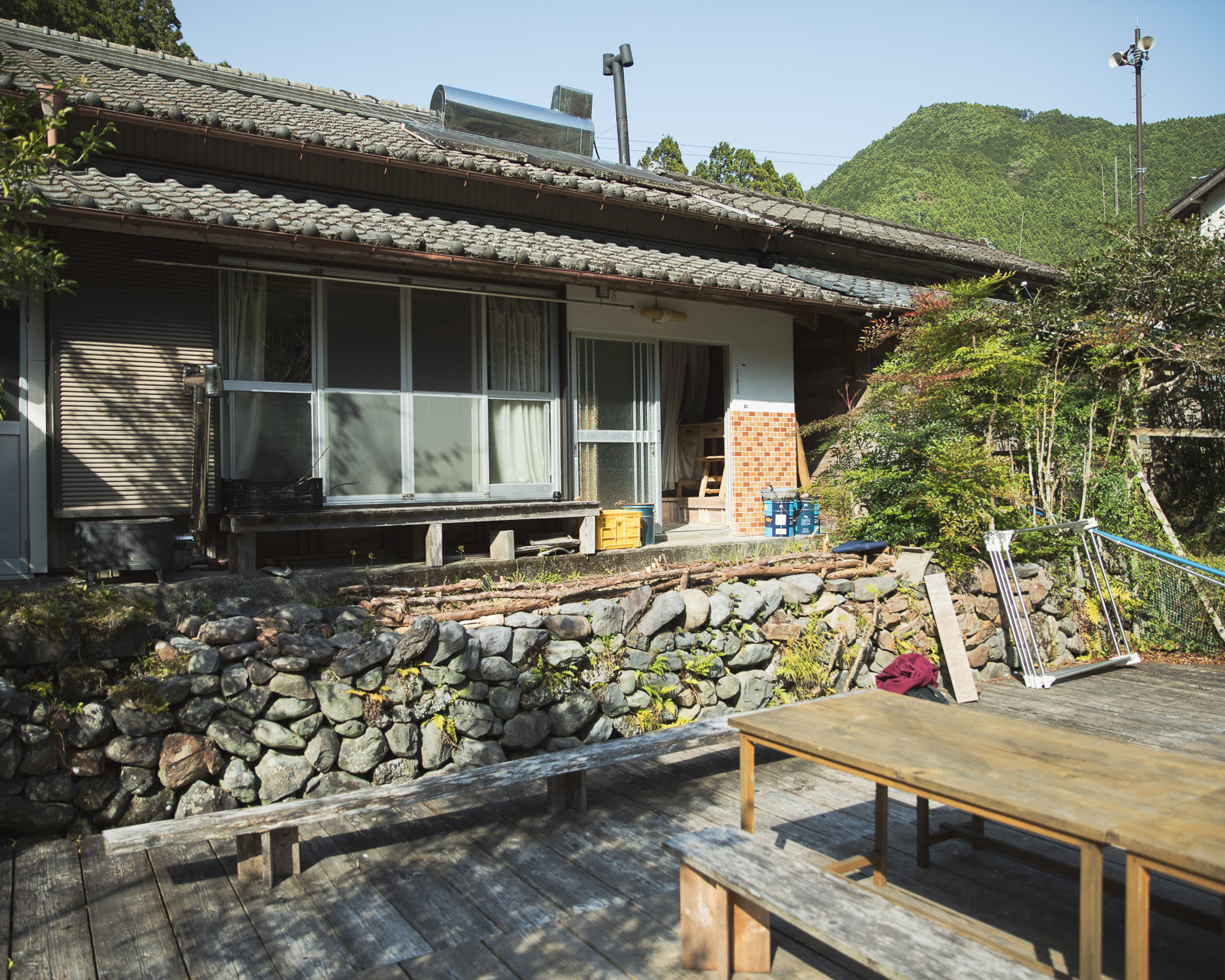
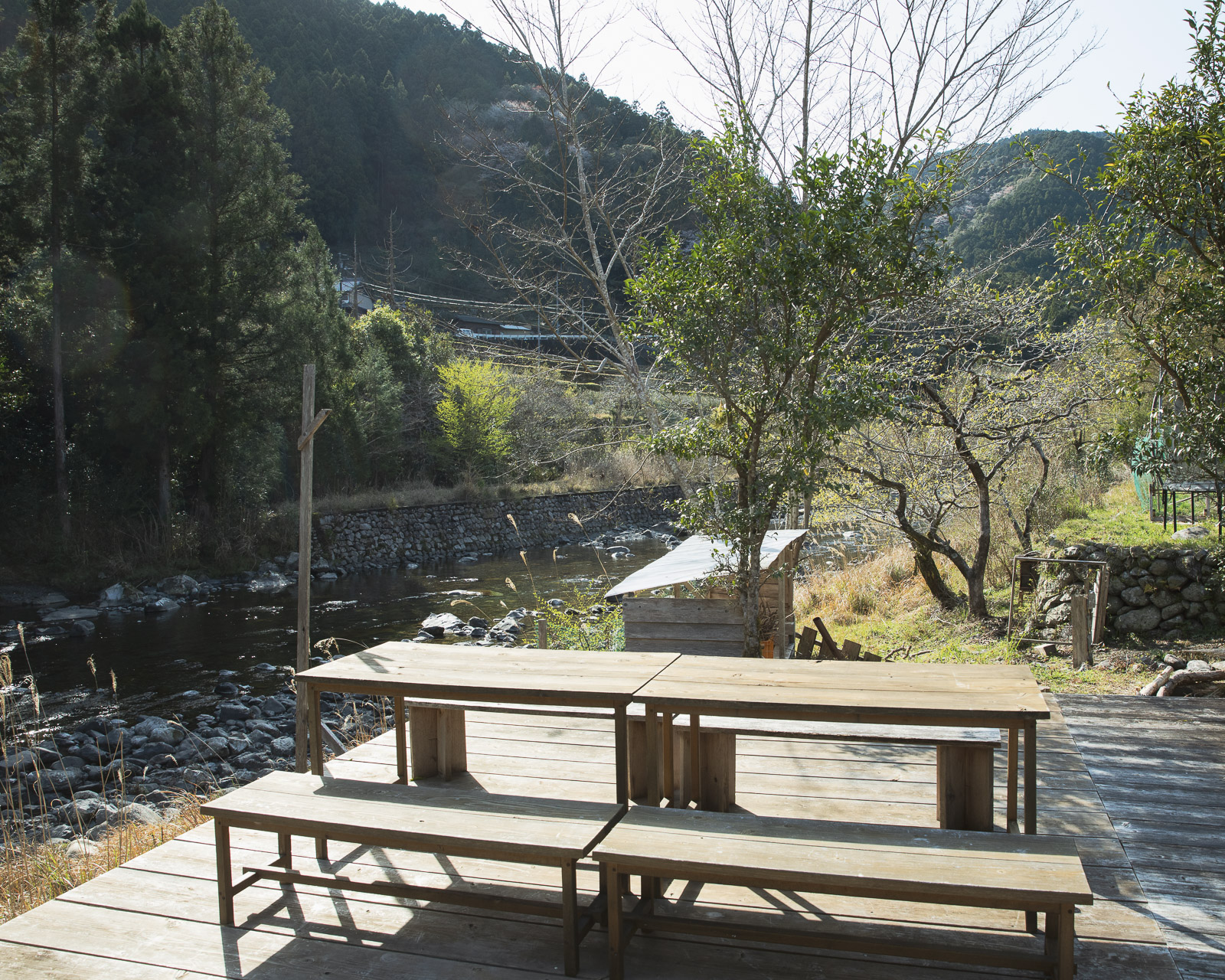
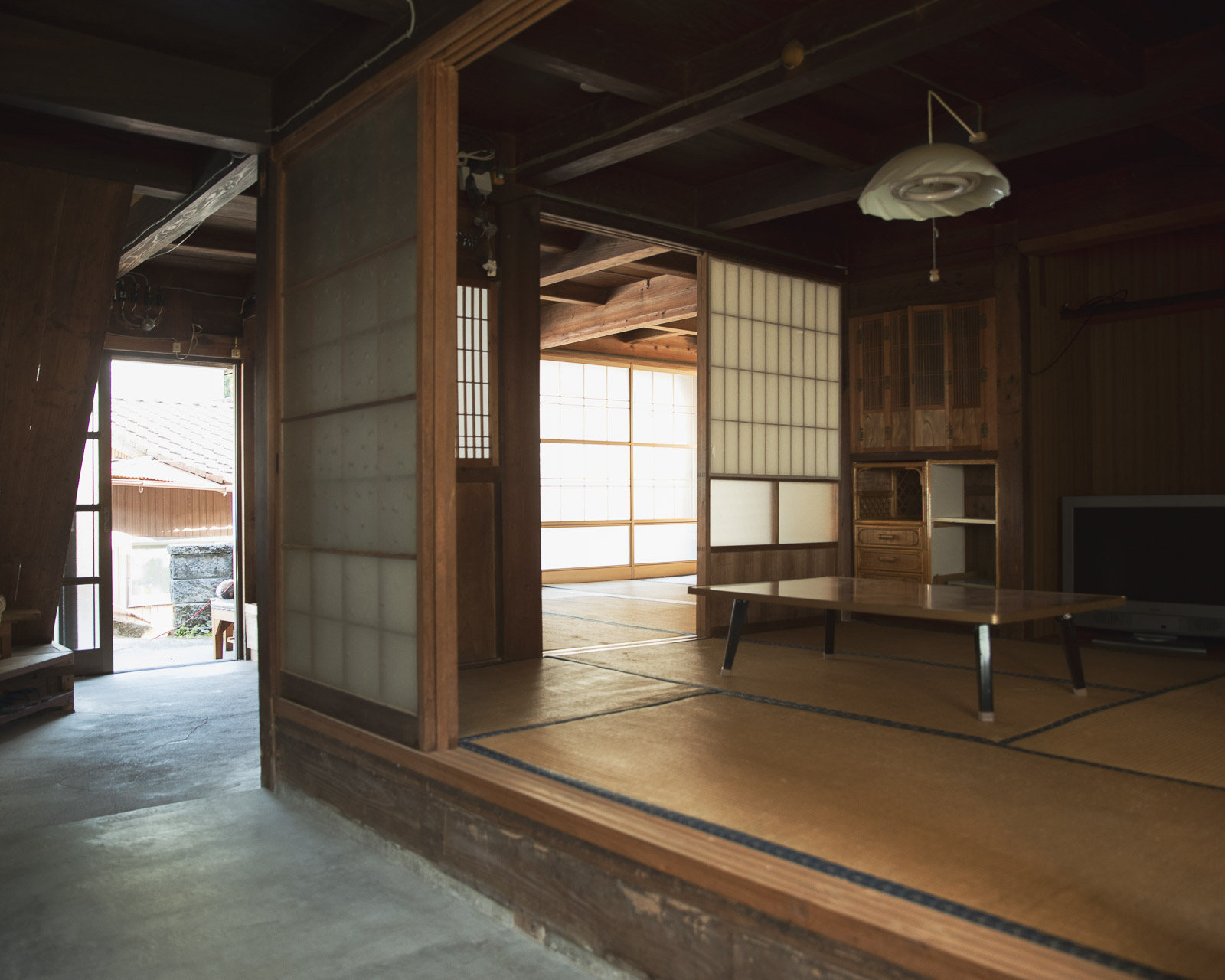
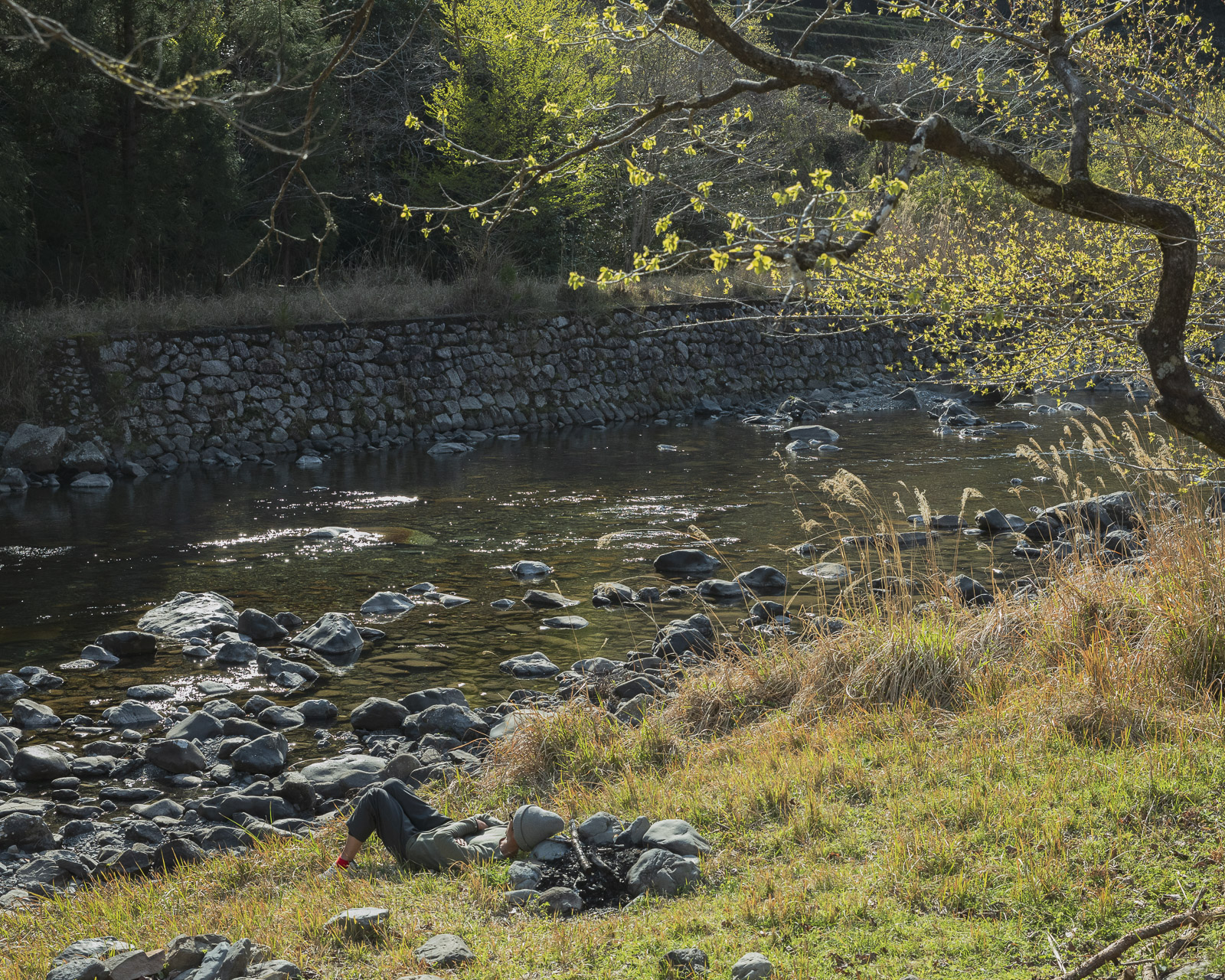
Kuo Green Village is located in Kaiyo, a town of around 8,300 residents, in Tokushima prefecture. DONI and his family live in the main house, and there’s a two-story guesthouse for visitors. A river flows nearby, and in the fields he grows chemical-free crops. DONI’s wife, Nami, also makes delicious macrobiotic meals.
Mysteries of breathing
ーFinally, let’s discuss breathing. Everyone does it. It’s essential for life. What’s fascinating is that breathing can be both conscious and unconscious. In that way, it’s unlike other bodily functions. We can’t stop the heart from beating or the stomach from digesting. Breathing is a function of the lungs. We can control it or let it happen on its own. Possibly the only time most people in Japan engage in breathing exercises in their daily lives is at the end of a session of rajio taiso (radio calisthenics, a short exercise routine that’s aired on public broadcaster NHK’s TV and radio channels several times a day).
Breathing exercises weren’t taught in school when I was younger. In recent years, there’s been more awareness ー more discussions about the importance of breathing. In yoga, breathing has a fundamental role. There’s a growing understanding of how breathing can actually be used to center ourselves as a tool for self-regulation. The phrase “take a deep breath and calm down” is a good example. Breathing is finally recognized as something to engage with. My question is this: What does breathing mean to you, personally? I imagine your answer is closely connected to yoga, and if so, I’d love to hear your thoughts on that, too.
Breathing can really be examined from many angles. There’s breathing for survival ー taking in oxygen, releasing carbon dioxide ー which everyone understands. There’s breath that’s linked to a mental state: When your breath is disturbed, your mind is disturbed, so take a deep breath and calm yourself. There are many ways to think about breathing. Recently, my son asked me: “Dad, what is breathing?”
ーAnd how did you respond?
I often bring him to my yoga classes, and at home we talk a lot about yoga. So he hears the word breathing all the time. But when he asked that question, I realized that even though I could list countless reasons why breath is important and beneficial, I wondered myself: “What is breathing?”
Most people would probably offer the standard explanation: the act of inhaling air (nitrogen, oxygen and other gases) and exhaling carbon dioxide and other gases. We can’t live without it. But there is more to it than that. So I told my son, “Let me think about it for a bit.” I spent time reflecting on what breathing means.

DONI’s son runs in the field next to Kuo Green Village.
What I realized is that breathing is one of the few methods through which humans can connect with nature. In yoga, there are various stages, and one of them involves becoming aware of where the self resides. Most people think it’s in the physical body. That’s the starting point. But yoga is a process of asking where the self begins and ends.
With breathing, most people think it’s something they do. But consider this: The moment you inhale air from just in front of your face, that air becomes part of your body. Where is the boundary between you and the outside world? It’s extremely vague. We think we are the ones breathing, but breathing doesn’t happen in isolation ー the act connects us to the world around us. In this modern age, we’re increasingly disconnected from that sense of unity with nature. No matter where we are or who we’re with, we are always connected ー through breath. Connected to nature. Connected to the universe. That’s the way I see it.
ーWhen you say we’re connected to nature, do you mean we’re one with it? A merging of the inner and outer nature?
Exactly. In fact, the fundamental teaching of yoga is that everything is one, while at the same time, each thing exists individually. There’s this awareness that we are both unique individuals and also part of the whole. Which leads to the question: “What am I?”
Most people think of the self as what’s inside the skin. But that gives rise to worries and emotions. Anger and frustration often come from seeing ourselves as self-contained units, separate from others. Once we realize that we are more than our physical selves ー of this body but not only of this body ー we begin to respect nature. The way we see the world shifts.
After all, our bodies couldn’t exist without nature. It’s one thing to understand that intellectually, but it’s something else to feel it. To reach that point, we have to look inward and explore ourselves deeply. There’s something similar in Zen: Turning your gaze inward brings clarity about the outside world.
Unconscious breathing versus conscious breathing
ーTake the act of seeing. In a past interview for this series, Roger McDonald explained that “Deep Looking” involves intentionally and attentively observing. That level of awareness changes the kind of information you take in and how connected you feel to the world. Breathing is the same. The quality of what you take in, and the depth of sensation you feel, changes depending on whether your breathing is unconscious or intentional. It’s not an abstract concept.
Breathing can be a way to feel the world, not just intellectually understand it. I believe that it’s a real, physical sensation. When your eyes are closed and your ears are covered, you can still sense the atmosphere or the weight and movement of the air through your breath. Even without our sight and hearing, breathing activates our senses and allows us to connect to the world. I feel that breath is one of our primary tools of perception.
That’s exactly right. I truly believe that breathing is a way of perceiving the world. When we compare unconscious and conscious breathing, its meaning and effect change dramatically. Yoga is essentially a practice for deepening breathing.
We spend a lot of time, energy and money thinking about what we eat or how we sleep. We talking about eating healthy food or we invest in beds to improve the quality of our sleep. But how many people think about working on their breathing? Probably not many. And yet, breathing is the most essential function for staying alive. You can go several days without eating or sleeping, but you can’t go 10 minutes without breathing. That’s how vital it is. Breathing circulates energy and sustains life.

ーThere’s a big difference between unconscious breathing and conscious breathing, isn’t there?
Absolutely. Unconscious breathing is, in most cases, very shallow. In that state of shallow breathing, the energy your body needs doesn’t circulate sufficiently. You’re not fully tapping into the innate power of your body and mind. I can say from my own experience that the quality and range of energy I felt before I started practicing yoga versus now is completely different.
When I talk about breathing, some people interpret it as something spiritual. In reality, it’s a physical act, rooted in the natural laws of the universe. Just like how sunlight nourishes plants and people live by eating those plants, we also receive energy from the air. Our ability to take in that air affects our energy levels. There’s a big difference between ordinarily inhaling through the nose, and inhaling while aligning the pelvis and keeping the spine straight to the crown of the head. The sensation of air entering the body feels completely different. When you breathe with good posture, it feels as though the breath seeps into your inner body, and that sensation deepens and spreads further.
When your breath reaches deep into your body like that, it feels as if energy is permeating every fiber. That is the transformative power of conscious breathing. Breathing is not just a biological function. I believe it’s a profoundly fundamental act that can change your awareness, your emotions and even your connection to others and your natural surroundings.
